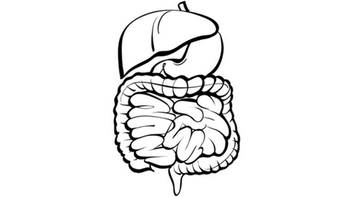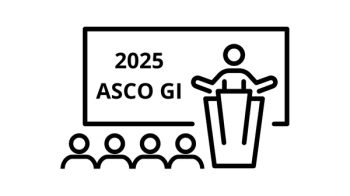
Case 3: PDGFRα D842V-Mutated GIST
Presentation and considerations for a case of PDGFRα D842V-mutated GIST.
Episodes in this series

Margaret von Mehren, MD: Let’s discuss platelet-derived growth factor alpha D842V–mutated GIST. I’m going to say PDGFRA D842V from here on out.
This is a case of a 72-year-old man who presented with abdominal pain, nausea, and fatigue. On exam, he had some diffuse abdominal pain on palpation. He was noted to be mildly anemic with a hemoglobin of 10.2 g/dL, platelets of 100 per mm3. Otherwise, normal labs. He had a submucosal lesion measuring about 5 cm in the stomach with some ulceration. A biopsy was done with EUS [endoscopic ultrasound] guidance, which showed a spindle cell with mixed epithelioid features. It was a GIST [gastrointestinal stromal tumor] with mitotic activity, which was high. On immunohistochemistry, the tumor was DOG1 positive and KIT positive, although weak. On CT imaging, it confirmed the findings and suspicious hepatic lesion was seen. The patient had an ECOG performance status of 1.
In a patient like this, who has a diagnosis of a GIST tumor with metastatic disease most likely, how do you proceed from this step? Jason, you might be referred this patient for surgery. What would you want to do?
Jason Sicklick, MD, FACS: I would further work up the liver lesion to better understand whether this was consistent with metastatic disease. In general, in my practice, I’ll obtain an MRI with Eovist, which is a contrast agent that’s very good for identifying very small, often subtle liver lesions, but it helps in distinguishing the metastatic disease vs benign liver lesions.
In the situation where we would identify that, there is a lesion concerning for metastatic disease, we would often also send the biopsy for sequencing at that point and try to decide whether we should treat them up front with neoadjuvant therapy with the goal of ultimately doing a curative intent operation vs going straight to surgery.
Margaret von Mehren, MD: Any other information that you would want, Rich or Mark, before starting therapy on this patient if we confirm metastatic disease?
Richard Riedel, MD: Jason alluded to the need for testing. We have some hints with the morphology being epithelioid, so I would want to have mutational testing. At our institution, we start with KIT. If negative, we reflex to PDGFR. I’d be interested to know what you guys do at your institutions.
Mark Agulnik, MD: I agree. From a cost perspective, that is the best strategy. For people who don’t have access to in-house testing, sending off for a full panel of NGS [next-generation sequencing] gets done because it is the most efficient way to get this information.
The 1 thing to highlight is to figure out what’s happening with the liver. This is a patient who, if they only had localized disease, would still merit from 3 years of adjuvant therapy, all else considered. Therefore, I have no hesitation as we’re working all this up to say maybe we need to start on something as I wait for the NGS, as I wait for other things to be figured out. Because ultimately, they’re going to be on something. But Rich’s strategy is probably the most cost-effective and the best strategy to do that, to do it in sequence as opposed to doing it all at once.
Jason Sicklick, MD, FACS: We would generally send it to the panel. The 1 thing to consider is this is probably from a small endoscopic biopsy, so you might not have enough tissue. You always have to consider the fact that if it’s a very small amount of tissue, and you send it off, you sequence it, and it’s negative for KIT mutations. You might be running out of tissue at that point, potentially.
Also, the other benefit to broader panel in my view would be capturing some of the other mutations, potentially SDH-mutant GIST, which is often going to be in the stomach as well and may have a mixed or an epithelioid histology as well, so you would potentially skip those additional steps in time in terms of identifying the potential mutation.
Margaret von Mehren, MD: That is a good point, although I have argued with my pathologists and we’re making strides with this. An easy screen for that is to test for the presence of SDHB. For those tumors that are SDHB-deficient, you won’t see the SDHB staining in the GIST tumor. That’s an easy screen. That’s not something that’s available in all pathology departments, but it’s probably the most cost-effective way of doing it if it can be implemented.
One of the things Mark alluded to is that somebody like this you want to get on therapy. In the past, I would have been comfortable to start and not wait for the mutational testing, although I have to say now that we have some therapies that can specifically target tumors that are resistant to imatinib. We haven’t talked a lot about that, but tumors that are resistant to imatinib. Particularly if I have a clue that this might be 1 such tumor, I might hold off starting on therapy.
Jason alluded to some of the cases where we think about tumors that are not going to respond to imatinib, so what were called in the past wild type because they didn’t express KIT or PDGFRA, we now understand have SDH mutations or lack of function. Then PDGFRA tumors—some are sensitive to imatinib, but there is a class of them. One of them in particular, D842V, which this case focuses on, is not. Knowing that there are some patients that are not going to respond to imatinib, you may want to think twice, particularly if you have some clues from the histology that perhaps a tumor is not going to respond.
Richard Riedel, MD: Jason, assuming the liver with your MRI study is not concerning for malignancy, I presume you would just take this out—whether it’s 5 cm in the antrum—and not consider neoadjuvant therapy. Correct?
Jason Sicklick, MD, FACS: Correct. We would go straight to surgery in that situation.
Richard Riedel, MD: Then you have ample tissue to do your molecular testing.
Mark Agulnik, MD: Correct, an ample amount of time to make decisions for adjuvant therapy.
Jason Sicklick, MD, FACS: Right.
Transcript edited for clarity.













































